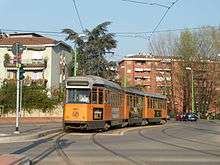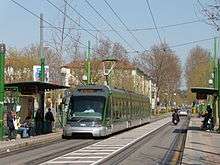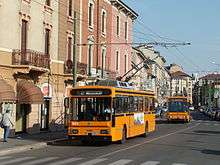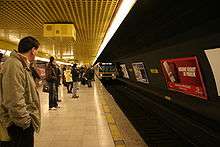Azienda Trasporti Milanesi
 | |
| Società per azioni | |
| Predecessor |
SAO (until 1893) Edison (until 1917) |
| Founded | Milan, Italy 1931 |
| Headquarters | Milan, Italy |
Area served | Milan metropolitan area |
Key people | Bruno Rota (Chairman)[1] |
| Services | Bus, tram and rapid transit lines operation |
| Revenue | €903.097 million (2010)[2] |
| €6.831 million (2010)[2] | |
| Owner | Comune di Milano |
Number of employees | 9484[3] |
| Subsidiaries | ATM servizi, Guidami, GESAM, Nord est trasporti (93.5%), Nuovi trasporti lombardi (74.5%), Mipark (51%), Perotti (51%), International Metro Service (Copenhagen Metro) (51%)[4] |
| Website |
www |
Azienda Trasporti Milanesi (ATM) is a public company, responsible for public transportation in Milan city and some surrounding municipalities, in Italy. It operates 19 tram lines, some of which are run with Peter Witt streetcars from the 1920s, 68 urban Bus lines, 4 Trolleybus lines, 51 interurban Bus lines, 4 underground lines (Metropolitana di Milano), carrying over 734 million passengers in 2010.[5]
ATM offers also other minor services mainly related to transportation around the city. These services include Radiobus, an on-call minibus service; the light railway linking the San Raffaele Hospital with the line 2 underground; the Como–Brunate funicular railway; GuidaMi car sharing and BikeMi bike sharing services.[6]
History



Public transport in Milan started on August 17, 1840, with the opening of the Milan-Monza railway. Horse-drawn buses were introduced in 1841. Services were run by the Società Anonima degli Omnibus (SAO), "Omnibus Anonymous Company". The company was responsible for 11 bus lines between 1861 and 1865.
Few years later the first horse-drawn trams were introduced: 3 lines were opened in 1881 followed in 1893 by the first electric tramway, built by Edison company. Two years later the same company opened 18 more lines, all ruled by municipality offices. Edison's concession on new lines expired in 1917, leaving all the operations to the municipality. Few years later the public offices responsible for public transport operations were made independent, becoming the Azienda Tranviaria Municipale (ATM) in 1931.
In the meantime, the first petrol powered bus lines were introduced in 1905, operated by SITA (Società Italiana Trasporto con Automobili) and then moved under control of ATM along with the first trolleybus line (1933).
After World War II resources were focused on bus lines and, since the mid-1950s, on the new metro. Milan Metro construction began in 1957 and in 1964 the first line was opened. Five years later the Line 2 was inaugurated.
On 1 January 1965, ATM changed its name to "Azienda Trasporti Municipali" (Municipal Transport Company). In these years a new generation of longer tram (jumbotram) were introduced. In the 1960s Italy and Milan saw a strong increase in car owners, and the increasing importance of private over public transport.
Several new stations of the two metro lines are opened in the following years. The new Line 3 was inaugurated in 1990. Tram line 15 to Rozzano was the first to go beyond the city border in 1992.
ATM changed its name again in 1999 to adopt the current one, "Azienda Trasporti Milanesi", and it became a S.p.a. in 2001. In these years, the first on-demand service, the Radiobus, was introduced to operate during the night.
The first fast tram line (Line 7) was introduced on 7 December 2002. This was followed by other 2 on 8 December 2003: Line 4 on the north and Line 15 on the south.
New magnetic tickets and electronic pass cards were introduced in 2004. The complete upgrade process took 3 years.



Network
Rapid transit
The Milan rapid transit network consists of 4 lines:
- M1 Sesto I Maggio - Rho Fiera / Bisceglie
- M2 Assago Milanofiori Forum / Abbiategrasso - Cologno Nord / Gessate
- M3 San Donato - Comasina
- M5 San Siro Stadio - Bignami
The network is more than 100 km (62 mi) long and serves 113 stations, mainly underground. The system has a daily ridership of over 1 million and is the biggest in Italy.
ATM also manages the Copenhagen Metro.
Tram Lines
The urban tram network comprises 16 lines fully within the city limits (1, 2, 3, 4, 5, 7, 9, 10, 12, 14, 16, 19, 23, 24, 27, 33), plus 2 lines linking the city centre with the hinterland (15 Milan-Rozzano, 31 Milan-Cinisello Balsamo), plus 1 interurban line (179 Milan-Limbiate).
Trolleybuses
The trolleybus network consists of 4 lines: lines 90 and 91 (known as la circolare, "Circle line") run around the city, while lines 92 and 93 serve some of the northern and eastern neighbourhoods.
Buses
ATM operates 68 urban bus lines and 51 interurban bus lines.
See also
Notes and references
- ↑ "Organizzazione". Azienda Trasporti Milanesi. Retrieved 15 October 2011.
- 1 2 "Bilancio ATM". www.atm-mi.it. Retrieved 24 September 2011.
- ↑ "Numeri ATM". www.atm-mi.it. Retrieved 24 September 2011.
- ↑ "Struttura ATM". www.atm-mi.it. Retrieved 24 September 2011.
- ↑ "Carta della Mobilità 2011" (PDF). Azienda Trasporti Milanesi. Archived from the original (PDF) on 29 March 2012. Retrieved 4 October 2011.
- ↑ http://www.atm-mi.it/en/IlGruppo/ChiSiamo/Pages/Attivita.aspx